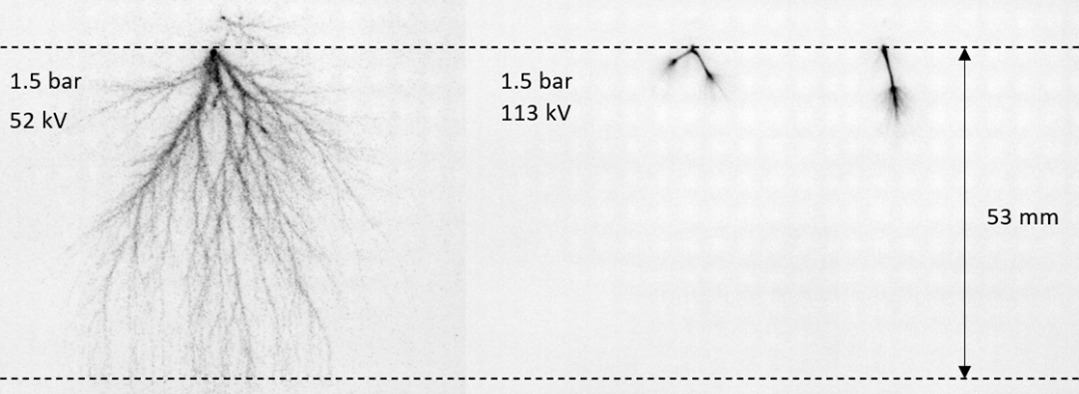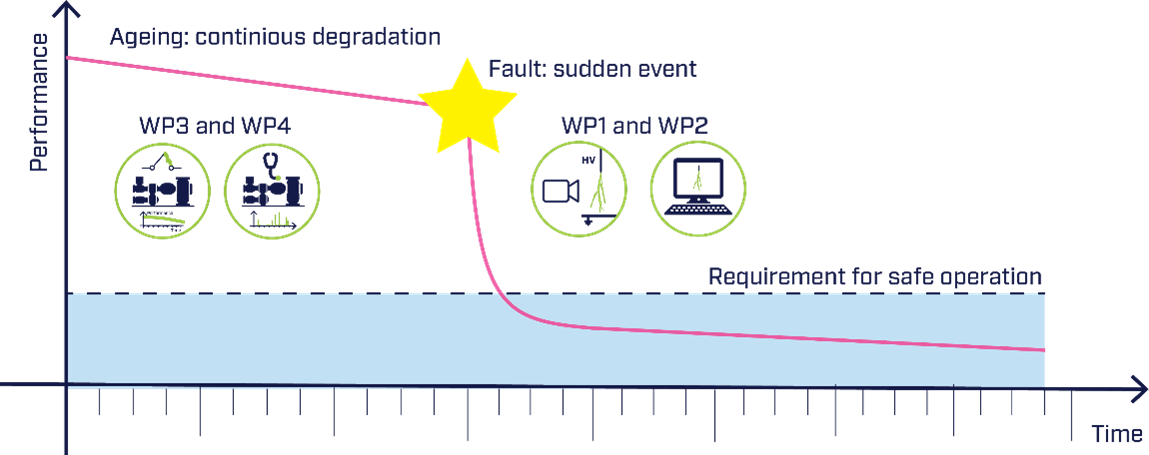While there are gases that could replace SF6 in GIS, more research is still needed, and SF6-free technology is still at an early stage of development. These are knowledge gaps that SINTEF’s “New Gases for GIS” project hopes to fill.
The problem with SF6
Sulphur hexafluoride (SF6) is a vital component in the high-voltage grid. It is used as a dielectric and current-interrupting medium, and among electrical insulating gases it is the unicorn, with a high breakdown strength, excellent current interrupting ability and good thermal conductivity. In addition, it has a low boiling point and can be used at a wide range of operating pressures and temperatures, and it even displays a substantial degree of self-healing after decomposition.
Despite its merits, SF6 has a major downside: it is the strongest greenhouse gas in existence. Just 1 kg of SF6 emissions is equivalent to 25 metric tons of carbon dioxide (CO2) emissions. Annual emissions from the Norwegian power grid currently amount to approximately 500 kg of SF6. For context, this is equivalent to 60,000 passengers taking one extra Trondheim to Oslo round trip flight every year. Or every Norwegian car driving an extra 46 km each year. Globally, thousands of tons of SF6 are released into the atmosphere every year. Although a majority of that is from the electrical grid, substantial emissions also come from other sources, such as AWACS aircraft. Historically, SF6 was also used in consumer products such as car tires, windows, and even shoes, a practice which is prohibited today.
According to The Intergovernmental Panel on Climate Change (IPCC), pathways to limiting global warming to 1.5˚C include reducing emissions from fluorinated greenhouse gases (like SF6) by up to 90% by 2050. Due its extreme global warming potential, and in spite of the fact that SF6 has no equal in high-voltage technology, the EU F-gas proposal targets a complete phase-out of SF6 in new electrical switchgear by 2031.

AIS or GIS
Air-insulated switchgear (AIS) and gas-insulated switchgear (GIS) are connection points in the high-voltage grid, and are essential for a safe and stable power supply. In a GIS, all parts that conduct electricity are enclosed in metal containers filled with pressurized SF6. In contrast, an AIS uses atmospheric air as an insulation gas. Since air is a poorer electrical insulator than SF6, AIS are much larger in size. Historically, high-voltage switchgears have been air-insulated. AIS are significantly cheaper than GIS and they are also easier to maintain. However, GIS are becoming an increasingly more common choice due to the total overall environmental footprint of AIS. Moreover, GIS are often the only choice when land for an AIS is not available (e.g., in large cities).
Is there an SF6 replacement?
Attempts to isolate a single alternative gas molecule that matches SF6’s technical performance have been unsuccessful. Rather, SF6-free technology has been diversified into using different insulating and current interruption mediums. Today, this technology relies on tailor-made gas mixtures, potentially also in combination with vacuum switches for current interruption.
The main gas mixtures used as SF6 replacements today consist of dry air or CO2, potentially enriched with a low concentration of fluorinated compounds. The new fluorinated molecules being used in GIS are perfluoronitriles (C4F7N or C4-FN) and perfluoroketones (C5F10O or C5-FK). Unlike SF6, these molecules degrade quickly in the atmosphere. For example, C5-FK has a global warming potential lower than CO2, while C4-FN has a global warming potential 2000 times higher than CO2, which is still significantly lower than SF6. In their pure form, both gases are stronger electrical insulators than SF6, but they have high boiling points and must therefore be mixed with other gases such as air or CO2 for usage in GIS.

Using pure technical air or CO2 is also viable and has its own set of advantages and disadvantages. For example, the global warming potential is then negligible and gas handling is also simpler. However, the technical performance of these gases is lower than the corresponding ketone- or nitrile-enriched mixtures, which can be compensated by increasing the GIS size and/or gas pressure.
Another medium for current interruption is vacuum. Circuit breakers with vacuum bottles dominate the market for low to medium voltages, and they are starting to gain market shares up to 145 kV and even 170 kV. For the highest transmission voltages, using vacuum is challenging; the insulation strength does not increase linearly with distance, and very large high-voltage vacuum gaps produce ionizing radiation.
Technology is evolving – research lags behind
The last 5-10 years have seen a proliferation of SF6-free technologies. Manufacturers are continuously revising their portfolios, but SF6-free equipment must be completely redesigned and tested, and new manufacturing lines must be established. The market lead time is therefore typically very long. Although SF6-free technology is rapidly evolving, it is still in its infancy and major technological challenges for the highest voltage ratings remain.
For end users, another concern is the lack of service experience with new SF6-free products. Only a few SF6-free high-voltage GIS have been installed around the world, and they have only been in operation for a few years. Building a knowledge base on ageing and failure mechanisms for this type of equipment requires dedicated research efforts. As high-voltage switchgear has an expected lifetime of more than 40 years, it is also a challenge for end users to feel sufficiently confident to invest in new technology in a phase where it is uncertain whether the several new products available in the market will all remain in supply in the future.
The “New Gases for GIS” project
The “New Gases for GIS” project launched in autumn 2021, with the aim of providing scientific insight into the most promising SF6 alternatives for medium- and high-voltage GIS. The four-year project brings together academia, end users, and manufacturers of SF6-free equipment and gas. It is led by SINTEF with NTNU, ETH, Statnett, National Grid UK, Elvia, Tensio, ABB, Hitachi Energy, GE Power, Hyundai Electric and 3M as partners.

The grid operators Statnett, National Grid, Elvia and Tensio are building pilot substations with various new SF6-free technologies. They have set ambitious SF6 emission reduction goals that rely on technological developments from GIS manufacturers, such as the project partners Hitachi, GE and Hyundai. SINTEF, NTNU and ETH will aid in this transition by addressing several R&D objectives for SF6-free technology in the project.
Fundamental insight and characterization
One of the research themes in New Gases for GIS is the characterization of fast breakdown phenomena in the new gas mixtures. This research follows two complimentary trajectories:
- Use ultrafast imaging for experimental characterization of electrical discharges.
- Predict and describe discharge physics through computer simulations.
Since electric discharges are exceptionally complex, we rely on advanced research infrastructure for both experiments and modelling. For example, images of the discharges are taken with extremely light-sensitive cameras that capture up to 1 billion frames per second over a wide spectral range (ultraviolet and visible). The first experimental results on discharges in a mixture of air and C5-FK have been presented at the Nordic Insulation Symposium in Trondheim. The modelling effort also relies on the availability of high-performance computing infrastructure in Norway. As there is no single factor that determines the electrical insulation properties of a gas, we approach the modelling problem by looking at the full picture, which includes plasma physics, radiative transfer, and electrodynamics.

SINTEF has developed state-of-the-art software for performing computationally intensive calculations of such discharges. Our software uses finite volume and particle methods on adaptive Cartesian grids and provides us with greatly expanded research capabilities. SINTEF and NTNU are collaborating with ETH for experimentally determining electron transport properties in the new gas mixtures, data which is used as input in dynamic and fully 3D discharge simulations. Our software is open source, and already runs on the largest supercomputers in Norway.

Aging and long-term performance
Unlike SF6, the nitrile and ketone molecules have no noticeable self-healing mechanisms. When they decompose during partial discharges or switching operations, they are permanently destroyed and only plasma by-products remain. Gas degradation over time is a significant concern for end-users, whose GIS installations are typically operational for several decades. One of the New Gases for GIS objectives is to investigate degradation mechanisms through accelerated aging tests. These experiments are performed with 1) partial discharges and 2) discharging a capacitor bank into electrical arcs in the gas (emulating a circuit breaker), followed up by voltage withstand tests. The experiments will be performed by SINTEF researchers and a PhD student whose thesis topic is on long-term degradation of novel insulation gases.

Aged gas is also being characterized using gas chromatography and Fourier transform infrared spectroscopy. The goal is to determine the decomposition rate of the different gas mixtures, and ensuring that detrimental by-products remain below specified critical limits. The experimental data is also being used for development of gas aging models that predict the cumulative effect of many subsequent switching operations, which can be used as a simplified condition assessment tool.
Project objectives
New Gases for GIS integrates the entire GIS value chain, addressing technological challenges with SF6-free technology. A range of topics from failure mechanisms, gas aging, and operational experience are addressed by the project partners. New gases for GIS will strengthen the scientific foundation of SF6-free equipment. Targeting long-term performance of the new insulation gases, the project is also contributing to identifying and reducing risk factors in the new technology. Mitigating such risks will reduce GIS outage periods, and ultimately facilitate a safer and faster transition to a climate-friendly electrical grid.
You can find out more about “New Gases for GIS” on its project page.












Comments
Thank you for comment and question.
These two recent CIGRE reports give a very good overview of the technical performance of non-SF6 gases:
https://e-cigre.org/publication/871-current-interruption-in-sf6-free-switchgear (2022)
https://e-cigre.org/publication/849-electric-performance-of-new-non–sf6-gases-and-gas-mixtures-for-gas-insulated-systems (2021)
However, they require a subscription for access.
The following review is open access, but a bit older (2017):
https://ojs.cvut.cz/ojs/index.php/PPT/article/view/4573
I hope this answers your question, otherwise please let us know.
Thank you so much for this article. I loved the part about self healing mechanisms. I have been researching different methods for a while now. Do you have any specific studies you could point me to that show the difference in SF6-free technology vs. our current “normal” technology?